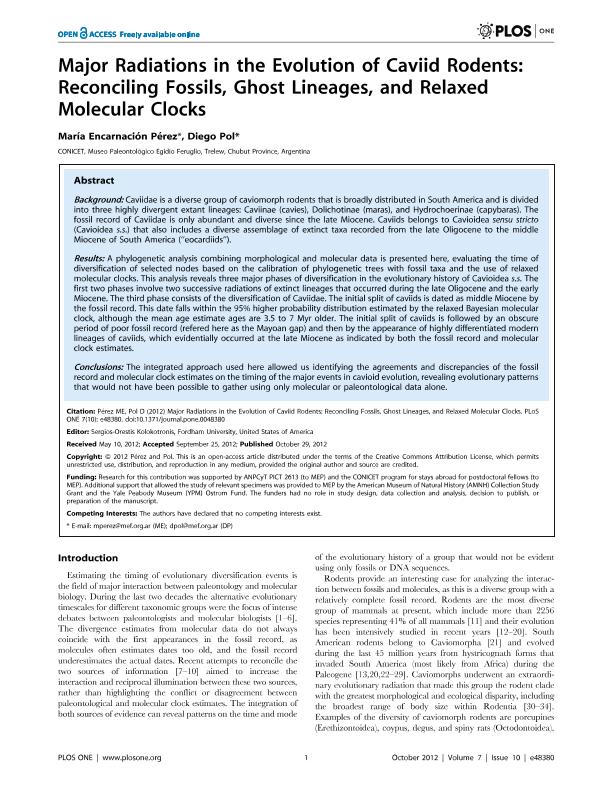Artículo
Major Radiations in the Evolution of Caviid Rodents: Reconciling Fossils, Ghost Lineages, and Relaxed Molecular Clocks
Fecha de publicación:
10/2012
Editorial:
Public Library of Science
Revista:
Plos One
ISSN:
1932-6203
Idioma:
Inglés
Tipo de recurso:
Artículo publicado
Clasificación temática:
Resumen
Caviidae is a diverse group of caviomorph rodents that is broadly distributed in South America and is divided into three highly divergent extant lineages: Caviinae (cavies), Dolichotinae (maras), and Hydrochoerinae (capybaras). The fossil record of Caviidae is only abundant and diverse since the late Miocene. Caviids belongs to Cavioidea sensu stricto (Cavioidea s.s.) that also includes a diverse assemblage of extinct taxa recorded from the late Oligocene to the middle Miocene of South America (??eocardiids??).A phylogenetic analysis combining morphological and molecular data is presented here, evaluating the time of diversification of selected nodes based on the calibration of phylogenetic trees with fossil taxa and the use of relaxed molecular clocks. This analysis reveals three major phases of diversification in the evolutionary history of Cavioidea s.s. The first two phases involve two successive radiations of extinct lineages that occurred during the late Oligocene and the early Miocene. The third phase consists of the diversification of Caviidae. The initial split of caviids is dated as middle Miocene by the fossil record. This date falls within the 95% higher probability distribution estimated by the relaxed Bayesian molecular clock, although the mean age estimate ages are 3.5 to 7 Myr older. The initial split of caviids is followed by an obscure period of poor fossil record (refered here as the Mayoan gap) and then by the appearance of highly differentiated modern lineages of caviids, which evidentially occurred at the late Miocene as indicated by both the fossil record and molecular clock estimates.The integrated approach used here allowed us identifying the agreements and discrepancies of the fossil record and molecular clock estimates on the timing of the major events in cavioid evolution, revealing evolutionary patterns that would not have been possible to gather using only molecular or paleontological data alone.
Palabras clave:
CAVIIDAE
,
FOSSIL
,
GHOST LINEAGES
,
MOLECULAR CLOCK
,
DIVERSIFICATION
,
SOUTH AMERICA
Archivos asociados
Licencia
Identificadores
Colecciones
Articulos(SEDE CENTRAL)
Articulos de SEDE CENTRAL
Articulos de SEDE CENTRAL
Citación
Pérez, María Encarnación; Pol, Diego; Major Radiations in the Evolution of Caviid Rodents: Reconciling Fossils, Ghost Lineages, and Relaxed Molecular Clocks; Public Library of Science; Plos One; 7; 10; 10-2012; 1-21
Compartir
Altmétricas




